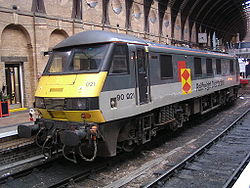
Railfreight Distribution
Encyclopedia

British Rail
British Railways , which from 1965 traded as British Rail, was the operator of most of the rail transport in Great Britain between 1948 and 1997. It was formed from the nationalisation of the "Big Four" British railway companies and lasted until the gradual privatisation of British Rail, in stages...
created by the division in 1987 of British Rail's previous Railfreight
Railfreight
Railfreight was a sector of British Rail responsible for all freight operations on the British network. The division was created in 1982 when BR sought to assign particular stock and management to the evolving requirements of freight traffic...
sector. It was responsible for non-trainload freight operations, as well as Freightliner and Intermodal services. In its early years the division was occasionally referred to as Speedlink Distribution. It was later responsible for freight operations through the Channel Tunnel
Channel Tunnel
The Channel Tunnel is a undersea rail tunnel linking Folkestone, Kent in the United Kingdom with Coquelles, Pas-de-Calais near Calais in northern France beneath the English Channel at the Strait of Dover. At its lowest point, it is deep...
.
With the privatisation of British Rail
Privatisation of British Rail
The privatisation of British Rail was set in motion when the Conservative government enacted, on 19 January 1993, the British Coal and British Rail Act 1993 . This enabled the relevant Secretary of State to issue directions to the relevant Board...
, the intermodal
Intermodal freight transport
Intermodal freight transport involves the transportation of freight in an intermodal container or vehicle, using multiple modes of transportation , without any handling of the freight itself when changing modes. The method reduces cargo handling, and so improves security, reduces damages and...
business was split off in 1995 to form a separate company called Freightliner
Freightliner (UK)
Freightliner Group Limited is a rail freight and logistics company, founded in 1995 and now operating in the United Kingdom, Poland, and Australia. It is the second largest rail freight operator in the UK, after DB Schenker Rail .- History :...
. In 1996, Railfreight Distribution was bought by EWS, later renamed DB Schenker Rail (UK)
DB Schenker Rail (UK)
DB Schenker Rail , before 2009 known as English, Welsh and Scottish Railway is a British rail freight company. EWS was established by a consortium led by Wisconsin Central Transportation Corporation in 1996 by acquisition of five of the six freight companies created by the privatisation of British...
.
Locomotives
By the end the fleet included several Class 47sBritish Rail Class 47
The British Rail Class 47, is a class of British railway diesel-electric locomotive that was developed in the 1960s by Brush Traction. A total of 512 Class 47s were built at Crewe Works and Brush's Falcon Works, Loughborough between 1962 and 1968, which made them the most numerous class of British...
, a group of Class 86s
British Rail Class 86
The British Rail Class 86 was the standard electric locomotive built during the 1960s, developed as a result of testing with the earlier Classes 81, 82, 83, 84 and 85. One hundred of these locomotives were built from 1965-1966 by either English Electric at Vulcan Foundry, Newton-le-Willows, or...
, a single Class 87
British Rail Class 87
The British Rail Class 87 is a type of electric locomotive built from 1973-75 by British Rail Engineering Limited . 36 of these locomotives were built to work passenger services over the West Coast Main Line . They were the flagships of British Rail's electric locomotive fleet until the late 1980s,...
(87101), a fleet of Class 90s
British Rail Class 90
The British Rail Class 90 electric locomotives were built by BREL at Crewe from 1987-1990. Each locomotive weighs 84.5 tonnes and has a top speed of . They operate from 25 kV AC overhead wires and produce...
, and Class 92s
British Rail Class 92
The British Rail Class 92 is a dual-voltage electric locomotive which can run on 25 kV AC from overhead wires or 750 V DC from a third rail. It was designed specifically to operate services through the Channel Tunnel between Britain and France...
, most of which were in store awaiting acceptance, however some of these were owned by European Passenger Services, and SNCF
SNCF
The SNCF , is France's national state-owned railway company. SNCF operates the country's national rail services, including the TGV, France's high-speed rail network...
these were operated as a common user pool.
The fleet was primarily based at Tinsley and Crewe Electric Depots at the time of privatisation, although many other depots were utilised during Railfreight Distribution's existence, mainly for shunting locomotives.
Liveries
In 1987 it introduced a new livery of two tone grey similar to those adopted by the Trainload FreightTrainload Freight
Trainload Freight was the sector of British Rail responsible for trainload freight services. It was formed in 1987 as a further development of the single Railfreight division created by BR in 1982, and existed until the onset of privatisation in 1994. The sector was subdivided according to the...
and Railfreight General
Railfreight
Railfreight was a sector of British Rail responsible for all freight operations on the British network. The division was created in 1982 when BR sought to assign particular stock and management to the evolving requirements of freight traffic...
subsectors, with a logo consisting of two red diamonds on a yellow background offset on top of a red rectangle. In 1992 in anticipation of the opening of the Channel Tunnel, the livery was revised to the 'European' version with a dark grey upper bodyside, a light grey lower bodyside, a blue coloured roof and 'Railfreight Distribution' lettering on the bodyside.

